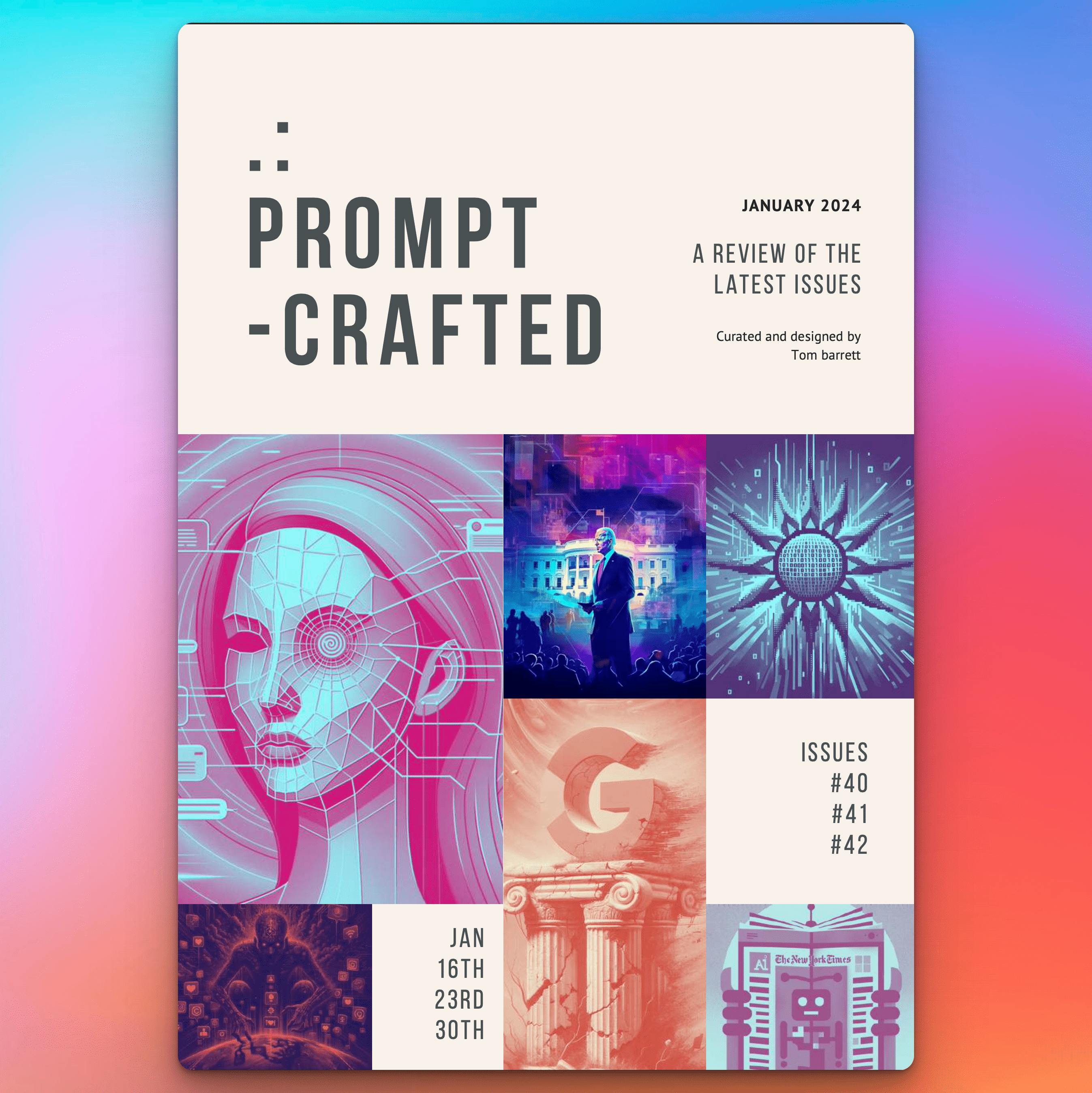|
Hello Reader,
Promptcraft is a weekly curated newsletter on AI for education designed to elevate your AI literacy.
In this issue, you’ll discover:
- Anthropic says its latest AI bot can beat Gemini and ChatGPT
- Google DeepMind Unveils AI ‘Genie’ to Instantly Conjure Playable Games
- Over Half of Business Users Employ Generative AI at Least Weekly
Let’s get started!
~ Tom Barrett

NEW MODELS
.: Anthropic says its latest AI bot can beat Gemini and ChatGPT
Summary ➜ Anthropic has launched its Claude 3 model family, which claims to have superior performance to OpenAI’s GPT-4 across ten public AI model benchmarks, marking a significant advance over the company’s 2.1 model release from November 2023. The introduction includes the Opus, Sonnet, and Haiku models, with Opus and Sonnet available for use in the API, and Haiku coming soon. The company also plans to release frequent updates to the Claude 3 model family over the next few months, including tool use, interactive coding, and more advanced agentic capabilities. Anthropic can now rival GPT-4 on equal terms and is closing the feature gap with OpenAI’s model family.
Why this matters for education ➜ These large language models are the engines that power our AI systems. The release of new models are significant milestones for the ecosystem.
I had to laugh at one commenter framing these announcements as if Anthropic with Claude-3 and Google with Gemini, have finally reached The Moon where OpenAI has been for a while, because everything is in comparison to the GPT-4 class models.
But, as they arrive, OpenAI, with the impending release of GPT-5, say,
Yep, and we are ready to go to Mars.
It is too early to tell what this means for education, but more choice is helpful. The benchmarks used for marketing are always a little misleading, and actual use on real tasks might tell a different story. I can access some of the new models via Poe, and I will give it a play; you can try the new model at Claude.ai
|

GAME DEV
.: Google DeepMind Unveils AI ‘Genie’ to Instantly Conjure Playable Games
Summary ➜ Google DeepMind’s Genie AI can create interactive, playable games from simple prompts by learning game mechanics from countless gameplay videos. With 11 billion parameters, Genie converts media into games, allowing users to control generated environments frame-by-frame. This groundbreaking model has the potential to revolutionise how AI learns and interacts with virtual environments, opening up new possibilities for training versatile AI agents.
Why this matters for education ➜ As young students, we are inherently world builders, naturally learning through play and conjuring up worlds that reimagine what we know into something entirely new. The development of text-to-game AI models, like Google DeepMind’s Genie, strikes a chord with me, highlighting how future students will face fewer barriers to creative expression. With the power of these AI tools at their fingertips, students can create simple sketches and bring their ideas to life, collaborating with game engines to adapt and refine their concepts. As AI-powered game creation tools become more accessible and integrated into learning experiences, I can’t help but feel excited about the possibilities that lie ahead.
|
|

AI ADOPTION
.: Over Half of Business Users Employ Generative AI at Least Weekly
Summary ➜ An Oliver Wyman report surveyed 200,000 people in 16 countries in November 2023, finding a 55% average adoption rate of generative AI. Adoption increased by 62% between June and November 2023. The technology industry had the highest adoption with 75% of white-collar workers using generative AI weekly. Healthcare and life sciences professionals use generative AI extensively, and consumers in many countries welcome it to expand healthcare access.
Why this matters for education ➜ These reports are important for us to be aware of, as they give educators a glimpse into what is happening across the ecosystem. Seeing the pace of adoption in every industry is an important provocation which I hope catalyses some action from school and system leaders. The other aspect I am interested in is a meaningful level of adoption.
Education showed the largest rise in use, with increases in 2023 of 144%. Forty-four percent of education industry employees report using generative AI weekly
In your organisation how many people are using GenAI every week? Every day? More than 40%?
|
:. .:
Connect & Learn
.: The humAIn community is growing!
Take a look at my online community to explore, connect and learn about AI for education.
💡 AI learning resources
🗣 Shared community forums
📅 Regular online community events
🫂 Connections with peers worldwide
✨ Guidance from three trusted community leaders
Join over 30 educators from Singapore, US, Australia, Spain and the UK.
|
Monthly Review
.: All the January issues in one convenient PDF
 |
Promptcrafted January 2024
Discover the future of learning with Promptcrafted – Tom Barrett’s monthly guide to AI developments impacting education…. Read more
|
Look out for information about the new February edition of Promptcrafted – coming soon!
|
.: :.
What’s on my mind?
.: Lift Your Gaze
In early 2022, the Grattan Institute, a prominent Australian think tank, released a report examining how better government policy might help make more time for great teaching.
The report explored the results of a survey of 5,442 Australian teachers and school leaders, finding more than 90 per cent of teachers say they don’t have enough time to prepare effectively for classroom teaching.
Teachers report feeling overwhelmed by everything they are expected to achieve. And worryingly, many school leaders feel powerless to help them.
This is amidst, and perhaps feeding, an education workforce crisis that is also being felt globally.
Amid this education workforce crisis, AI has emerged as a potential solution – but one that comes with its own set of challenges and opportunities. When the number one issue is a lack of time, a tool that purports to time-save is likely to be adopted quickly, sometimes unquestioningly.
There are two friction points here: the sleepwalking into AI adoption when we know a wide range of literacies, such as media bias and understanding the capabilities and limitations of AI systems, need to mature alongside good prompting.
The other is that we get comfortable with low-level replacement tasks, the ‘grunt work’, the time savers – and we do not look beyond the marginal productivity gains.
As I say, the poor health of the current learning ecosystem has complex conditions in which to adopt a powerful, generative set of new technologies.
This is not to say that saving time is not helpful, important, or even critical for education to be sustainable. Go get that first draft of the email, expand on those lesson starter ideas, and build a bunch of open-ended questions to get you started!
But I want us all to consider what happens when we have saved all the time there is to save. How are we stretching the capabilities of AI systems and, in turn, stretching and reshaping what might be possible in teaching and learning?
I still think this is initially explored in daily tasks and productivity. So, when mapping out a medium-term plan of six lessons, ask yourself: What could I create with AI that I would never have had the time or resources to create before? Could I design something that was previously out of reach?
The next time you sit down to get stuck into some precious learning design, consider what would typically be inconceivable. What is usually out of reach for me? How could I push the boundaries of what’s possible?
We need more educators who know enough about how to save time, who have gathered the low-hanging fruit and are now ready to lift their gaze and design new ways to reach higher and further.
:. .:
~ Tom
|
Prompts
.: Refine your promptcraft
A reminder this week of the powerful image creating tools like Midjourney.
These have really advanced quickly across the last few months and the images below were created using Midjourney version 6.
These are powerful tools to bring ideas to life. What do you think of my orc warlord?
Here’s the full prompt:
Character design close-up, intimidating orc warlord with battle-scarred green skin, heavy spiked armour, and a massive war hammer, unreal engine
Or, perhaps you prefer my inventor?
Character design close-up, brilliant gnome inventor with wild purple hair, goggles, a tool belt, and a steam-powered mechanical arm, unreal engine
You can see how little text we have to write to get some amazing results. A fun way to bring some character writing to life for students. Which in turn, generates some further visual cues for writing.
Please also note the promptcraft includes “Character design close-up” for the type of image, then details, and the style key is “unreal engine”.
These prompts were inspired by the ideas in this great article exploring Midjourney in depth.
:. .:
Remember to make this your own, try different language models and evaluate the completions.
Do you have a great prompt you would like me to share in a future Promptcraft issue? Drop me a message by replying to this email.
|
Learning
.: Boost your AI Literacy
RESEARCH
.: Preparing for AI-enhanced education: Conceptualising and empirically examining teachers’ AI readiness
Teachers’ readiness for integrating AI into education is crucial for the success of AI-enhanced teaching.
This study defines AI readiness based on cognition, ability, vision, and ethics and explores how these components impact teachers’ work, innovation, and job satisfaction.
Here are some other study highlights:
- Teachers’ AI readiness were conceptualised from cognition, ability, vision, and ethics in the educational use of AI.
- Teachers’ cognition, ability, and vision in the educational use of AI were positively associated with ethical considerations.
- The four components of AI readiness all positively predicted AI-enhanced innovation and job satisfaction.
- Teachers with high levels of AI readiness perceived low AI threats and demonstrated high innovation and job satisfaction.
- Teachers from different socio-economic regions and of different genders showed no significant differences in AI readiness.
CLIMATE
.: AI’s Climate Impacts May Hit Marginalised People Hardest
Artificial intelligence (AI) technology, while celebrated for its potential in weather forecasting, also plays a significant role in exacerbating the climate crisis, according to a report from the Brookings Institution.
The report warns that AI’s soaring energy consumption and environmental costs could disproportionately impact marginalised communities already vulnerable to global warming.
Training a chatbot, for example, requires the same amount of energy as 1 million U.S. homes consume in an hour. The report highlights the potential for AI’s climate impacts to worsen existing environmental inequities related to extreme heat, pollution, air quality, and access to potable water in areas reliant on fossil fuels, often near poor communities.
CLIMATE
.: The Staggering Ecological Impacts of Computation and the Cloud
An interesting exploration of the environmental impact of computation, the cloud infrastructure AI models rely on, and the ecological costs of ubiquitous computing in modern life.
The article highlights the material flows of electricity, water, air, heat, metals, minerals, and rare earth elements that undergird our digital lives.
It discusses the environmental impact of the Cloud, such as carbon footprint and water scarcity. The article also explores the acoustic waste data centres emit, known as “noise pollution.”
|
Ethics
.: Provocations for Balance
➜ So you have saved time. Now what?
➜ How can we reframe the conversation around AI in education to focus on its potential for transformative change beyond efficiency gains?
➜ Could this technology stifle creativity and imagination in young people, who might become reliant on AI for generating ideas instead of developing their own?
Inspired by some of the topics this week.
|
:. .:
.: :.
The more we invest in our understanding of AI, the more powerful and effective our education ecosystem becomes. Thanks for being part of our growing community!
|







/cdn.vox-cdn.com/uploads/chorus_asset/file/25332126/Screenshot_2024_03_12_at_11.21.50_AM.png?w=960&ssl=1)




